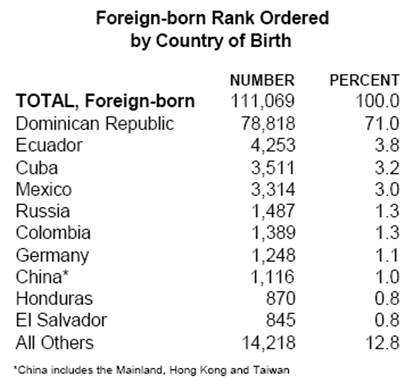Community Health Profiles
*Please note: Dated information compiled in 2008A survey of New York City residents found that people who report having significant emotional distress are more likely to engage in unhealthy behaviors, such as getting no exercise, binge drinking, smoking, and eating a poor diet. Similarly, New Yorkers with significant emotional distress experience high rates of chronic illness, such as high cholesterol, high blood pressure, obesity, asthma, and diabetes. An added difficulty is that neighborhoods in New York with the lowest incomes often have the highest rates of significant emotional distress, often adding to the burden on these already underserved communities (New York City Department of Health and Mental Hygiene, 2003). The New York City Department of Health and Mental Hygiene (DOHMH) has conducted a number of community health surveys to assess the health and well-being of New Yorkers. Here, we present some of the factors important to the physical and mental health of the communities of Central Harlem, Washington Heights, and Inwood, to serve as background for the project proposed herein.
Inwood and Washington Heights:
Manhattan’s Community District 12 is composed of the neighborhoods of Inwood and Washington Heights (I/WH). The population of these neighborhoods at the year 2000 census was 270,700. More than half of the residents of these communities (51%) were born outside the United States, compared to 36% for New York City as a whole.
FIGURE 1: FOREIGN BORN POPULATION (I/WH), REGIONS OF ORIGIN COMMUNITY DISTRICT 12
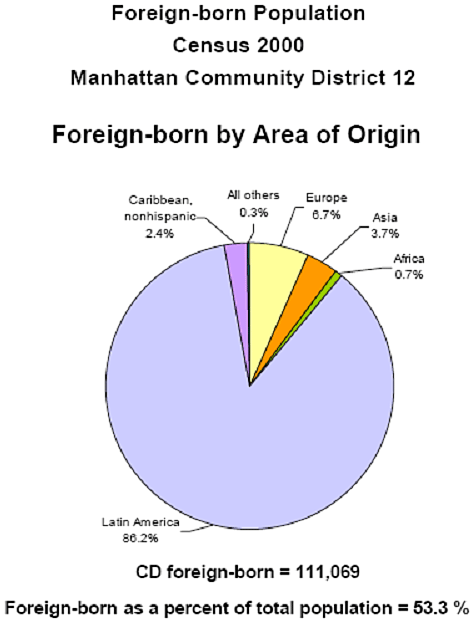
SOURCE: (NEW YORK CITY DEPARTMENT OF CITY PLANNING, 2006B)
TABLE 1: FOREIGN BORN POPULATION (I/WH), COUNTRY OF BIRTH COMMUNITY DISTRICT 12
SOURCE: (NEW YORK CITY DEPARTMENT OF CITY PLANNING, 2006B)
The vast majority of residents are ethnically Hispanic, though a diverse mix of races and ethnicities exists in these neighborhoods (New York City Department of Health and Mental Hygiene, 2006c). The 2000 census for Community District 12 lists 54.3% of residents of I/WH as being “Proficient in English” while 45.7% of respondents are not proficient (for respondents age 5 and older) (New York City Department of City Planning, 2006b).
FIGURE 2: RACE/ETHNICITY IN INWOOD AND WASHINGTON HEIGHTS
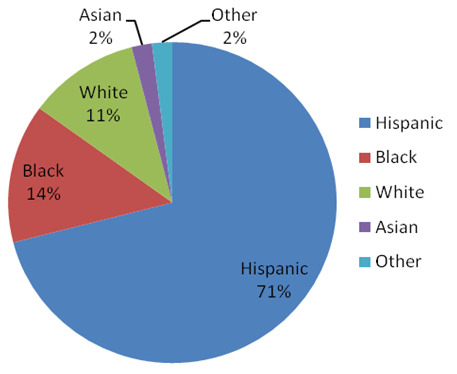
SOURCE: (NEW YORK CITY DEPARTMENT OF HEALTH AND MENTAL HYGIENE, 2006C)
TABLE 2: LANGUAGE PROFICIENCY, 2000 CENSUS, MANHATTAN COMMUNITY DISTRICT 12
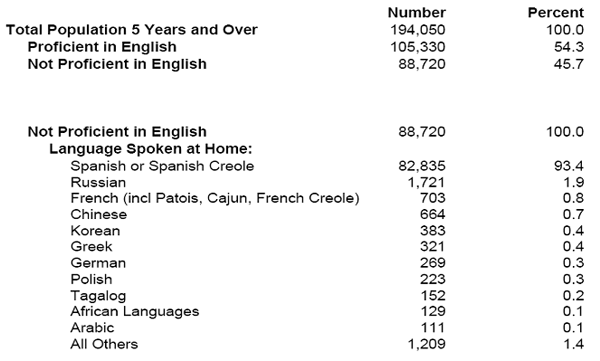
In Inwood and Washington Heights, 31% of residents live below the poverty level, compared to an average of 21% for New York City as a whole. Further, 32% of residents consider their health to be fair or poor, compared to 21% of all New Yorkers (New York City Department of Health and Mental Hygiene, 2006c). In general, residents of I/WH show average rates of the health indicators surveyed by the New York City Department of Health and Mental Hygiene (New York City Department of Health and Mental Hygiene, 2006c). However, residents of these neighborhoods are more likely to be uninsured than those in Manhattan overall (20% vs. 13%). Another 13% of residents were uninsured at some time during the past year (New York City Department of Health and Mental Hygiene, 2006c).
Some of the major health problems in these neighborhoods are related to obesity, diabetes, and heart disease. More than 1 out of 5 adults in I/WH are obese and more than 1 in 10 have diabetes. About half of residents report not exercising at all on a regular basis (New York City Department of Health and Mental Hygiene, 2006c). Perhaps an over-arching factor in these health problems is the fact that about one third of adults in these neighborhoods do not have a regular doctor (New York City Department of Health and Mental Hygiene, 2006c). Residents born outside of the United States are even less likely to have a regular health care provider, as they may experience greater barriers in access to health services. Residents of Inwood and Washington Heights also showed greater symptoms of psychological distress and mental illness in the 2006 Community Health Survey than residents of other New York City neighborhoods.

Note (DOHMH definitions):
Non-specific psychological distress, 2006: Non-specific psychological distress is a composite measure of 6 questions regarding symptoms of anxiety, depression and other emotional problems.
Frequent mental distress, 2006 : The exact survey question was: “Thinking about your mental health which includes stress, depression, and problems with emotions, for about how many days during the past 30 days was your mental health not good?”
History of depression, 2006: The exact survey question was: “Have you ever been told by a doctor, nurse, or other health professional that you have depression?”
New diagnosis of depression, 2006: The exact survey question was: “Were you first told you had depression in the past 12 months?”
CENTRAL HARLEM
The population of Central Harlem at the year 2000 census was 151,100. Nineteen percent (19%) of residents were born outside of the United States. The majority of residents are Black, though other races and ethnicities are also represented in this neighborhood (New York City Department of Health and Mental Hygiene, 2006b). The 2000 census for Central Harlem’s Community District 10 lists 88.6% of residents as being “Proficient in English” while 11.4% of respondents are not proficient (for respondents age 5 and older) (New York City Department of City Planning, 2006a)
FIGURE 3: FOREIGN BORN POPULATION (HARLEM), REGIONS OF ORIGIN COMMUNITY DISTRICT 10
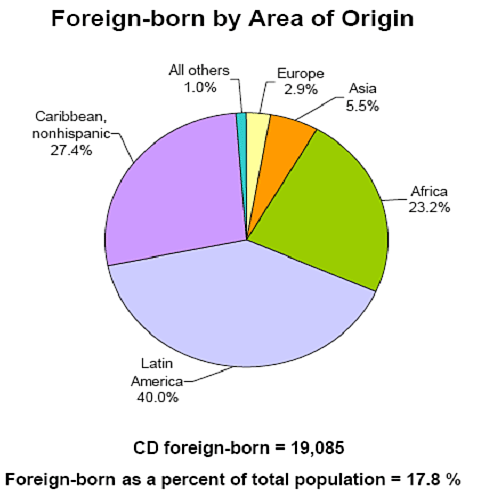
SOURCE: (NEW YORK CITY DEPARTMENT OF CITY PLANNING, 2006A)
TABLE 6: FOREIGN BORN POPULATION (HARLEM), COUNTRY OF BIRTH COMMUNITY DISTRICT 10

SOURCE: (NEW YORK CITY DEPARTMENT OF CITY PLANNING, 2006A)
FIGURE 4: RACE/ETHNICITY IN CENTRAL HARLEM
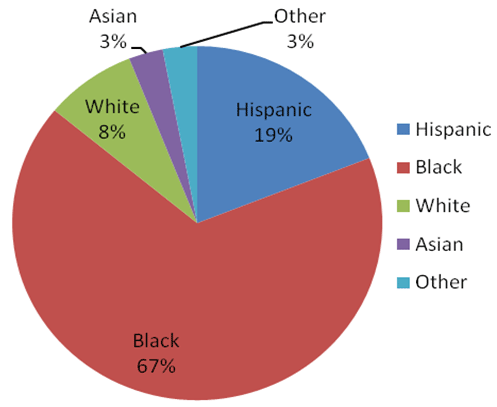
SOURCE: (NEW YORK CITY DEPARTMENT OF HEALTH AND MENTAL HYGIENE, 2006B)
TABLE 5: LANGUAGE PROFICIENCY, 2000 CENSUS, MANHATTAN COMMUNITY DISTRICT 10

SOURCE: (NEW YORK CITY DEPARTMENT OF CITY PLANNING, 2006A)
In Central Harlem, 35% of residents are below the poverty level, while the rate in New York City as a whole is 21%. Twenty-two percent (22%) of residents consider their health to be fair or poor – about the same as the proportion for New York City in general. About 12% of residents of Central Harlem are uninsured at a given time (compared to 18% for NYC altogether), though an additional 10% were uninsured at some time during the past year (New York City Department of Health and Mental Hygiene, 2006b).
Almost 3 out of every 10 adults in Central Harlem are obese, and over 1 in 10 have diabetes. In a related finding, almost half of residents do not get any physical activity on a normal day. About 24% of residents do not have a primary doctor, but this rate is consistent with the average for the rest of New Yorkers (New York City Department of Health and Mental Hygiene, 2006b). Residents of Central Harlem, in some cases, showed greater symptoms of psychological distress and mental illness in the 2006 Community Health Survey than residents of other New York City neighborhoods. 

